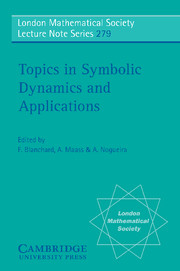Book contents
- Frontmatter
- Contents
- FOREWORD
- 1 SEQUENCES OF LOW COMPLEXITY: AUTOMATIC AND STURMIAN SEQUENCES
- 2 SUBSTITUTION SUBSHIFTS AND BRATTELI DIAGRAMS
- 3 ALGEBRAIC ASPECTS OF SYMBOLIC DYNAMICS
- 4 DYNAMICS OF ℤd ACTIONS ON MARKOV SUBGROUPS
- 5 ASYMPTOTIC LAWS FOR SYMBOLIC DYNAMICAL SYSTEMS
- 6 ERGODIC THEORY AND DIOPHANTINE PROBLEMS
- 7 NUMBER REPRESENTATION AND FINITE AUTOMATA
- 8 A NOTE ON THE TOPOLOGICAL CLASSIFICATION OF LORENZ MAPS ON THE INTERVAL
6 - ERGODIC THEORY AND DIOPHANTINE PROBLEMS
Published online by Cambridge University Press: 05 August 2013
- Frontmatter
- Contents
- FOREWORD
- 1 SEQUENCES OF LOW COMPLEXITY: AUTOMATIC AND STURMIAN SEQUENCES
- 2 SUBSTITUTION SUBSHIFTS AND BRATTELI DIAGRAMS
- 3 ALGEBRAIC ASPECTS OF SYMBOLIC DYNAMICS
- 4 DYNAMICS OF ℤd ACTIONS ON MARKOV SUBGROUPS
- 5 ASYMPTOTIC LAWS FOR SYMBOLIC DYNAMICAL SYSTEMS
- 6 ERGODIC THEORY AND DIOPHANTINE PROBLEMS
- 7 NUMBER REPRESENTATION AND FINITE AUTOMATA
- 8 A NOTE ON THE TOPOLOGICAL CLASSIFICATION OF LORENZ MAPS ON THE INTERVAL
Summary
Vitaly BERGELSON
The Ohio State University, Department of Mathematics
231 West 18th Avenue, Columbus, OH 43210–1174
U.S.A.
Introduction
The topic of these notes is the interplay between ergodic theory, some diophantine problems, and the area of combinatorics called Ramsey Theory.
The first section deals with some classical and well-known diophantine results and their connections with topological and measure-preserving dynamics. Some of the proofs offered in Section 6.2 are very elementary, while some use ergodic-theoretic machinery which is actually much more sophisticated than the results it gives us as applications. This should not in any way discourage the reader since the author's intention was not to produce proofs that are as elementary as possible (see Appendix), but to show how intertwined the different and seemingly remote areas of mathematics may be.
The combinatorial results discussed in Sections 6.3, 6.4, and 6.5 are more recent, but they are as beautiful and, in our opinion, as important as the diophantine facts dealt with in Section 6.2.
It was H. Furstenberg, who, with his publication in 1977 of the ergodic-theoretic proof of Szemerédi's theorem (see Section 6.4), established the link between Ramsey theory and the theory of multiple recurrence. Since then, many open problems of combinatorics and number theory have been solved by the methods of ergodic theory and topological dynamics (see for example, [15], [16], [17], [5], and [6]). As it happens, the developments brought to light many new and intriguing problems which are of interest to both the ergodic theory and combinatorics.
- Type
- Chapter
- Information
- Topics in Symbolic Dynamics and Applications , pp. 167 - 206Publisher: Cambridge University PressPrint publication year: 2000
- 8
- Cited by

